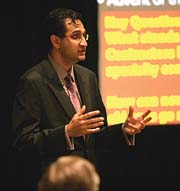
Because technological advances, scientific breakthroughs, and changing social structures are accelerating the pace of change at an ever-increasing rate, last year the Mechanical Contractors Association of America (MCAA), through its Mechanical Contracting Education and Research Foundation (MCERF), commissioned futurist Atul Dighe to conduct a study to determine which forces were likely to have an impact on the mechanical contracting industry over the next 15 years. At the recent 2004 MCAA Convention in Orlando, Dighe came back with his report, "Five Key Trends for the Future of the Mechanical Contracting Industry."
Simply put, Dighe told convention attendees that the mechanical contracting industry will face the pressures of significant change between now and the year 2020. Dighe, the principal and senior futurist with the consulting firm of Social Technologies LLC, believes that marketplace, societal, and technological trends will create challenges and opportunities for the entire industry.
"Actions and decisions made today will shape the overall success and profitability of the industry over the next 15 years," noted Dighe. "Smart mechanical contractors realize that as the industry changes, they are left with two options: complain and see profits continue to decline, or change and adjust and seek new and perhaps more lucrative ways of doing business.
"I hope with this report, you adjust accordingly and make a difference."
Dighe identified the following as the five key trends affecting the industry:
1. Workforce 2020 - or, how will the industry attract talented workers?
2. Evolving value chain - or, how will new revenue models be identified?
3. Era of rebuilding - or, how will the industry help rebuild America's infrastructure?
4. Sensor technology - or, how will sensors change the entire nature of the mechanical contracting business?
5. Materials science - or, how will new material technology revolutionize construction?
The Future Workforce
Addressing the question of how the industry will attract talented workers for the workforce of the future, Dighe noted that by 2010, Hispanics will be the single largest population group in the prospective labor pool for the construction industry. At the same time, the millennial generation (children born between 1980 and 2000) will be entering the workforce, and Dighe cautioned, "the worker of tomorrow may look and have different expectations than the worker of today.""Millennials have grown up in an era of high technology, group interaction, and racial integration," he said. "The employers and industries that embrace these values will attract the best and brightest of the millennials."
By 2020, Dighe also pointed out that the baby boomers will be in their 60s and 70s.
"Their attitude towards retirement and passing on - or letting go of - the leadership reigns of their mechanical contracting companies will go a long way towards determining the strength of the industry in 2020," he stated in his written report.
In the end, he said recruiting, retaining, and training talent will be the most significant key to the industry's growth over the next 15 years. One of his recommended steps was partnering with the UA to add a focus on minority recruitment and training systems that relate more to the millennials through multimedia or game-based direction.
"For union mechanical contractors, fostering a strong collaborative relationship with their union counterparts will be crucial in determining the industry's ability to successfully take advantage of all of the emerging market opportunities," he said. "A unified message of growth, flexible training, opportunity for advancement and entrepreneurship will be vital for the viability of union mechanical construction over the next 20 years."
‘Virtual General Contractor'
Over the past decade, the answer to the question, "Who does what on the jobsite?" has become more muddled as work processes have evolved, according to Dighe. Overlapping roles and skills sets among mechanical, electrical, and sheet metal contractors have blurred the boundaries that separate these specialty contractors. And, he noted, this trend will only increase.At the same time, he noted that reserve auctions and direct purchases of equipment by the end user will also increase over the next 10 years. Those contractors who can identify their unique features and services more clearly to the marketplace will be ahead of the game in the future, he said.
"By 2020, profit will be based largely on customer service, reliability, and the ability to coordinate and lead other specialty contractors," he said, hinting that a well-coordinated set of specialty contractors could replace the role currently held by the general contractor. "By 2020, ‘virtual general contractors,' comprised of specialty contractors working together, will manage the majority of construction projects. There is going to be a specialty contractor who can take this role," he told the crowd. "It might as well be you."

Rebuilding
All of these trends, Dighe noted, should be considered opportunities. For instance, over the next 20 years, people's changing needs for buildings will create new market opportunities, he predicted. Because buildings built during the 1960s are now old and in need of repair, he said the demand for renovation and updating of public buildings and the infrastructure "will comprise a large portion of the commercial construction market." Look for more renewed efforts at downtown area revitalization, too."Many of these projects will include rebuilding commercial property into residential property," he said. "This increase in new urban dwellers will create a related need for additional commercial services."
As the older generations pass on, Dighe noted that the baby boomer generation "is positioned to inherit about $2 trillion."
"While some of this wealth transfer will occur in liquid assets, much will come in the form of property," he maintained. "The choices baby boomers make in regards to how this wealth is spent will drive the direction of the U.S. economy over the next 20 years."
"The opportunities will be there," he said.
Bring On The Sensors
With sensor technology becoming more powerful, portable, disposable, and pervasive, Dighe said mechanical contractors should expect the technology to be built into all mechanical systems in the future to enable self-diagnosis of system problems."As a result, by 2015, the majority of mechanical systems servicing work will be scheduled preventive maintenance," he said. "There will be increasingly fewer unforeseen system problems or emergencies."
By 2005, Dighe noted that Wal-Mart will require every product on its shelves to be equipped with radio frequency identification (RFID) tags. He said such technology could help manufacturers to move further towards a just-in-time production and delivery model.
"By 2010, all parts and components used in mechanical systems will have integrated RFIDs, revolutionizing inventory management and the ordering process," he predicted.
With sensors gathering billions of data on a daily basis, coordination and communication skills will become crucial, he added. The ability to determine which piece of information gets communicated to which system will be a highly sought after skill, he predicted. "By 2010, the specialty contractor who masters the skills of coordination and communications among sensor-enabled ‘smart' systems and people will be the first among equals of the specialty contractors," he maintained.
Robot Technicians?
Last, but not least, expect breakthroughs in materials sciences - including nanotechnology, synthetics, alloys, and plastics - to create a whole new suite of lighter, stronger construction materials. As a result, materials used in all phases of construction by 2020 will be significantly different than those used today, predicted Dighe."The first thing built on every jobsite could be a materials factory that will produce some or all of the materials needed for that particular job," he said.
There may be a downside to this new technology, especially for the service technician, he warned. "Smart" materials that combine nanotechnology and sensing "nanorobots" could create "self-healing materials and systems" by 2015, said Dighe.
"The service contractor's technician of the future could be a microscopic, versatile robot that can continually monitor and repair systems and materials," he said.
Journey Into Tomorrow
Wrapping up his discussion, Dighe noted that his report is intended to provide those employed in the mechanical contracting and services industries guidance for making decisions about how to best pursue the myriad opportunities before them."This report is intended to be the beginning of our journey into tomorrow," he said. "On this journey lie many golden opportunities, as well as several critical challenges. This study begins to create a roadmap for the future of the mechanical contracting industry.
"However, the nature and destination of that journey will be greatly influenced by the attitude and preparation with which mechanical contractors confront the question, ‘What kind of industry do we want to create for the year 2020?'"
Publication date: 05/03/2004



